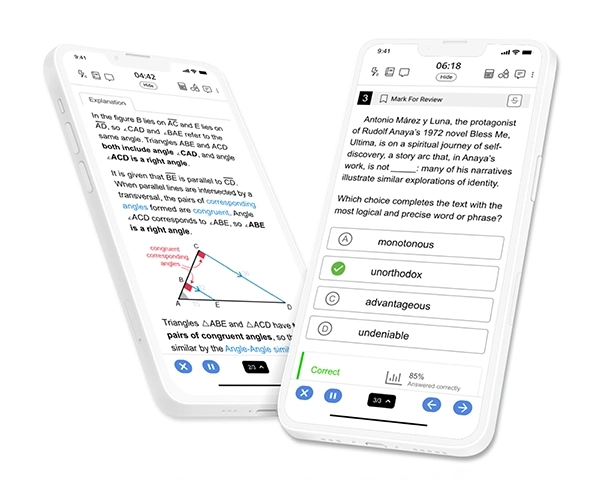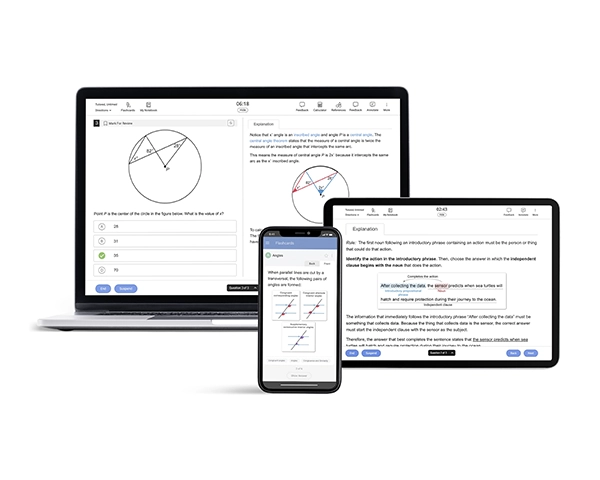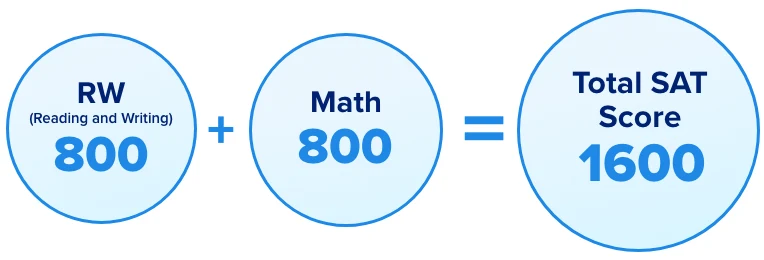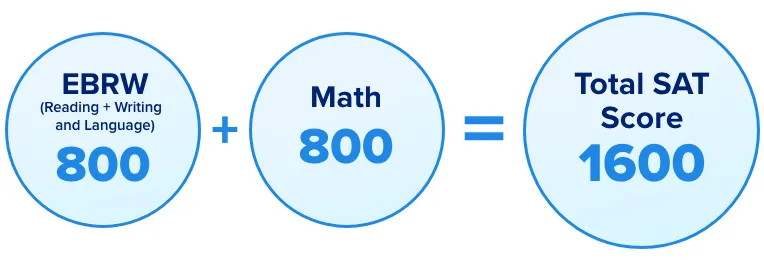About The SAT®
Your Complete Guide To The College Board® Digital SAT®
The SAT® is a standardized test created and administered by the College Board® to help high school students get into four-year colleges and earn academic scholarships. The updated version of this exam, the Digital SAT®, is an adaptive multiple-choice timed test that measures your overall college readiness and will be the only version of the SAT test available for students to take from 2024 onward.
What does SAT stand for? Originally called the Scholastic Aptitude Test, the full form of the SAT was later changed to the Scholastic Assessment Test. However, as this test has evolved over time and grown in popularity, SAT is no longer considered an acronym.
SAT Overview
If you are in your junior or senior year of high school and are planning to go to college, then the Digital SAT is a test you shouldn’t miss. In this article, we will walk you through everything you need to know about the SAT paper-and-pencil and digital tests – including the benefits of taking the SAT (either version), its old and new format, and its scoring system.
What is the SAT used for?
The SAT, both paper-and-pencil and digital, is one method through which universities may measure your potential as a prospective student for either admissions or merit-based financial awards. Standardized testing has historically been used to help colleges identify talented students and provide a common vantage point to compare all applicants because educational curricula and standards vary across the country. In recent years, many colleges have transitioned to a test-optional admissions process, which allows students to decide whether or not to submit standardized test scores as a factor in their college application. Although a small percentage of schools don’t look at SAT scores to review a student’s potential, most colleges still consider this exam as an important benchmark. Now more than ever, students can demonstrate their academic prowess with outstanding standardized test scores. Additionally, students can qualify for merit-based scholarships that use SAT scores as a qualifying criterion.
Who can take the SAT?
All high school students are eligible to take either version of the SAT. The College Board has not set an age limit for students to take the test. However, there are a few other factors to consider before registering for the test. To learn more, refer to the SAT eligibility requirements page.
When is the SAT held?
The SAT is administered nationally seven times a year, on Saturdays in March, May, June, August, October, November, and December. However, if you are taking the SAT outside of the U.S., Puerto Rico, or the U.S. Virgin Islands, you might have to take it on different dates. Refer to the complete list of SAT dates and schedule for 2023-24. All administrations of the exam in 2024 will be of the Digital SAT only.
When do you take the SAT? In what grade do you take the SAT?
Most students take the SAT for the first time in the spring of their junior year. The College Board recommends taking the SAT in your 11th or 12th grade. There is no age limit for taking the SAT, but it is recommended that you take the PSAT 8/9/10 (Preliminary SAT) in your 9th and 10th grades to prepare yourself for the SAT.
In addition, you can even take the SAT after high school. One of the major advantages of the SAT is that you can retake it as many times as you want. Many students take the SAT more than once to improve their scores and get a superscore. Check out our page on retaking the SAT.

Digital SAT vs. Paper Format
Students take the Digital SAT online through the BluebookTM testing app. The digital version of the SAT is shorter than the paper-and-pencil version, with fewer questions, but the scoring structure of the two testing interfaces has not been changed. This change in format is expected to improve the test's quality, security, delivery, and accessibility for students worldwide. Our guide to the Digital SAT is here to answer your queries about the new testing interface, format, question types, and other changes.
Format of the digital SAT
The Digital SAT has undergone considerable changes in the test format and length. The Digital SAT test consists of two sections: Reading and Writing (RW), and Math. The following table summarizes the number of questions and the time allotted for each section on the digital SAT:
| Digital SAT | ||
|---|---|---|
| Component Test | No. of Questions | Time per test |
| Reading & Writing | 54 | 1 hr 4 mins |
| Math | 44 | 1 hr 10 mins |
| Total | 98 | 2 hr 14 mins |
Similar to the paper-and-pencil SAT, the Digital SAT tests you on a variety of skill sets indicating your overall college readiness. Here’s an outline of the topics you’ll be tested on:
1. Reading and Writing
You will see shorter passages as compared to the paper-and-pencil version. However, the section will be split into two separately timed modules. The RW section will test you on:
- Comprehension
- Vocabulary
- Rhetorical Synthesis
- Text Structure and Purpose
- Recognizing implicit meanings in the texts
2. Math
The Math section will be split into two separately timed modules of 35 minutes each. Calculators can be used for both modules. Below is the list of topics you will be tested on:
- Algebra
- Advanced Math
- Problem-solving/data-analysis
- Geometry and Trigonometry
How does Digital SAT scoring work?
The Digital SAT will be scored in a similar manner to that of the paper-and-pencil version. Each section will be scored on a scale of 800, making the total SAT score 1600. In short,
The table below shows the score distribution for the Digital SAT:
| Scoring Section | No. of Questions | Total Raw Score | Scaled Score |
|---|---|---|---|
| Reading & Writing | 54 | 54 | 800 |
| Math | 44 | 44 | 800 |
| Total Scaled Score | 1600 | ||
Format of the SAT
The table below shows the number of questions and the time allotted for each of the component tests on the paper-and-pencil SAT:
| Paper-and-Pencil SAT | ||
|---|---|---|
| Component Test | No. of Questions | Time per test |
| Reading | 52 | 1 hr 5 mins |
| Writing and Language | 44 | 35 mins |
| Math | 58 | 1 hr 20 mins |
| Total | 144 | 3 hrs |
The paper-and-pencil SAT test consists of three component tests, namely, Reading, Writing and Language, and Math. Each component assesses you on different skill sets and consists of various question types. Let’s explore each component test and learn about what the SAT test consists of.
1. Reading Test
The Reading Test consists of five short passages with 10 – 11 multiple-choice questions for each passage. The Reading Test assesses you on three aspects:
- Comprehension
- Vocabulary
- Recognize implicit meanings in sentences
2. Writing and Language
The Writing and Language Test consists of four passages followed by multiple-choice questions. There are 11 MCQs for each passage. This test assesses you on the following skills:
- Edit and improve grammar errors
- Punctuation
- Word choice
- Sentence structure
- Tone
3. Math
The first section does not allow you to use a calculator. But you can use a calculator in the second section. Each of these sections is separately timed. Below is the the list of topics you will be tested on:
- Algebra
- Problem-solving/data-analysis
- Graphs
- Equations
- Nonlinear expressions
- Geometry
- Complex numbers
- Trigonometry
How does paper and pencil SAT scoring work?
The scoring system of the SAT is distributed across two sections. The first section includes two tests, the Reading Test, and the Writing and Language Test. These two tests, combined, form the Evidence-Based Reading and Writing section (EBRW). The second section consists of the MathTest. In short,
The table below shows the score distribution for the paper and pencil SAT:
| Scoring Section | Component Test |
No. of Questions | Total Raw Score | Scaled Score |
|---|---|---|---|---|
| EBRW | Reading | 52 | 52 | 800 |
| Writing and Language | 44 | 44 | ||
| MATH | Math | 58 | 58 | 800 |
| Total Scaled Score | 1600 | |||
If you want to know more about the paper and pencil or the digital test, refer to the SAT Test format page. Our guide to the SAT Syllabus is here to help you with a detailed description of the Reading & Writing and Math Tests.
How Important is the SAT?
If you are wondering whether it is important to take the SAT, below are a few pointers to help you out that apply to both the paper-and-pencil and digital versions of the test:
-
The SAT is essential for some highly competitive four-year colleges
Though many colleges and universities have adopted test-optional policies, submitting a strong SAT score helps a candidate showcase their academic excellence to stand out among a saturated pool of talented applicants.
-
The SAT score boosts your chances of receiving college funding
As college tuition is expensive, a high SAT score can mean scholarships, thus reducing the financial burden. Having a good SAT score is a must if you wish to receive merit-based scholarships that use college entrance exam scores as a qualifying criterion.
-
SAT score reports can be more reliable than high school transcripts
Because the SAT is an international standardized test, a good SAT score tells colleges that you have taken a uniform, timed test and proven your merit. In addition, your SAT score report gives colleges a good way to judge how college-ready you are, especially if you went to a high school they don't know.
-
Your SAT scores help colleges find you
When you register for the SAT and opt-in for the Student Search Service, your name is shared with colleges. This opportunity allows colleges to contact you based on your SAT test scores, grades, and academic interests.
-
SAT scores may affect college placement
Some colleges use SAT scores to place students in classes that are appropriate for their reading, writing, and math skill levels. Scores can also be used to determine whether students can benefit from advisors or academic support in college.
Why Should You Take the SAT?
We understand that high school can be rigorous, and you might wonder whether studying for an extra admission test could burn you out. Because preparing for either version of the SAT requires you to walk that extra mile, we often hear students ask, “Is the SAT worth taking?" especially now that so many schools have made the tests optional If you are asking the same question, let’s look at the reasons:
-
Boost your college applications
The SAT score report is a way for college admissions officers to see how far you've evolved academically throughout high school and gauge your overall college readiness. A strong SAT score provides clear evidence of your academic abilities, especially considering the diverse educational curricula and standards across the country.
-
Make up for a low GPA
Most colleges take SAT scores into account in addition to high school transcripts during the admissions process. A good SAT test score can show colleges your academic potential if your GPA falls short.
-
College Course Placement
Some colleges will use your performance on the SAT test for college course placement to determine which level of courses you fit into. If you submit exceptional scores on the SAT test, you may be able to skip introductory-level courses.
-
You get more time per question on the SAT
The SAT (both versions) gives you more time per question compared to other tests like the ACT® (American College Testing). So, if you are planning to take a standardized timed test that doesn’t make you race against time, the SAT would be ideal for you.
-
Your state or high school might require the SAT
Some states require students in high school to take the SAT on SAT School Day. If you are a resident of any of these states, you might end up taking it even if the college you are applying to does not require it for admission.
Is the SAT Hard?
Whether the SAT is hard or easy, it is a matter of what your strengths are. The SAT tests you on your reading, writing, analytical, and mathematical skills, which is a way to assess your college readiness. Students who take both versions of the SAT may find the Digital SAT slightly less challenging because it is an adaptive test designed to serve questions aligned to student skill level in the second module of each section exam.
Here are a few factors to keep in mind that could affect your SAT performance:
-
Lack of study schedule
It can be hard to balance your high school studies with SAT preparation, and most students falter on this. Since the SAT is a timed test, you need a dedicated study schedule to help you plan out how to prepare. Also, keep in mind that the Digital SAT covers different question types and content than the old paper-and-pencil version. We recommend that students who have previously studied for the paper-and-pencil SAT also set aside dedicated time to study for the Digital SAT to make sure they understand the new format, topics, question types, and time constraints.
-
Time Constraint
Although the Digital SAT offers you more time per question than the ACT, it is still a timed test where you need to manage your time effectively to be able to answer the questions. Time management could be a tricky factor that can make or break your Digital SAT score.
-
The Reading and Writing test could be challenging
The Digital SAT Reading and Writing Test can be more tricky to prepare for than the math section. You will need to practice reading many short passages from different genres, analyzing them, and answering questions in a short time frame.
-
Practice is key
Study-practice-repeat! Taking practice tests will help you identify the areas you are struggling with and evaluate your time-management skills.
The SAT is one of the most crucial tests impacting your college journey. Plan, focus, and work hard towards your target score. If you are looking for a premium practice test that offers you detailed answer explanations and Digital SAT test-like questions, you can check out UWorld’s Digital SAT Prep Course. Our practice tests and questions also let you know how you did compared to other students preparing for the exam. Try a free trial and see how you did!
Study on your schedule, at your pace, and at an affordable price.

References
- The Digital SAT® Suite of Assessments Specifications Overview. (n.d.). satsuite.collegeboard.org. Retrieved 2023, from
https://satsuite.collegeboard.org/media/pdf/digital-sat-test-spec-overview.pdf - When Should You Take the SAT? (2023, December 18). College Board Blog.
https://blog.collegeboard.org/when-should-you-take-the-sat - What’s the Difference between the SAT and the PSAT-Related Assessments? (2018, June 29).
https://blog.collegeboard.org/difference-between-sat-and-psat - How Colleges Use Admission Tests – BigFuture. (n.d.).
https://bigfuture.collegeboard.org/plan-for-college/applying-to-college/tests/8-things-to-know-about-how-colleges-use-admission-tests

